 |
An Architect Looks Back
By Ashihara Yoshinobu Page 2 Page 2
The Navy
My wife, Hatsuko, is the younger sister of a former classmate at Seijo. We got to know each other on the tennis courts at the famous Karuizawa summer resort, which is remarkable only because that is how Japan's Crown Prince met his wife. We wanted to get married before I went into the navy, but that did not work out. Beginning that year, the navy had started a system whereby architectural engineers could enlist for officer training. So we said our goodbyes and I went into the navy. I was sent to Chintao for training and came back as an officer trainee. I became a sub-lieutenant. It turned out I was to go to New Guinea as company commander of a construction team. I figured I would probably not come back and that Hatsuko and I might never see each other again, but I went off bravely all the same.
The construction team was formed in Tokyo and we set out in a pair of ships. I was commander of the fourth company. Off the Philippines we were attacked by a submarine and one ship was sunk, we picked up the oil-covered survivors of that vessel and somehow made it to Harumahera Island, then finally to New Guinea. I must have been well resigned to fate, for I really did not feel all that afraid. The companies under me were made up of a rough-and-ready breed-gang bosses, carpenters, construction workers, and such-I was just a raw university graduate with absolutely no experience in the real world. Still, a strong solidarity grew up among us after that submarine attack, and we got along quite well. After that, the greater the danger we faced, the harder everyone worked.
Once we got to New Guinea we commenced to build an airstrip at the front lines. On Navy Day in May, before a single Japanese aircraft had touched down there, it was bombed. We withdrew to Ambonia Island, but before we left, thinking it a waste if the airstrip we had worked so hard to build was never used for anything at all, one of the army surgeons and I took out a couple of tennis rackets and a ball and volleyed the ball around-very quickly because it was dangerous-and then left. After that I was in Harumahera for a time until I received an order to return to Japan. I traveled to Ambonia aboard a reconnaissance plane. I had to sit on the equipment below the pilot's seat, and it was very uncomfortable so I used my sweater as a cushion. In all the excitement I went off and forgot that sweater, and it was one Hatsuko had knit for me before I left Japan.
Marriage
I returned safely to Japan, and began work building an airbase in Chiba, which is a peninsula just east of Tokyo. At the end of the war I was at Kisarazu Air Base (Chiba prefecture), but before that we were married. Our marriage took place on December 24, 1944 in nearby Kashima, a rather desolate, unattractive place where there was an air force division, and my assignment on the construction project. At the hotel where we stayed on our wedding night near Sahara Station-and the place was about as desolate as the desert by the same name-I remember there was a group of suicide pilots drinking in the bar.
After demobilization, Hatsuko and I returned to Yotsuya, but my family home and the houses of all my relatives had been burned down. Fortunately, Hatsuko's house in Sangubashi was still standing, so we moved in there, but it was already inundated with homeless relatives, so we had to take up housekeeping in the maid's room. My brother was given some corner there too-it was quite a press for a while.
To Harvard
For some time I worked at a small architectural firm in Tokyo, but I was determined to go to the United States to study, so I took the examination for a GARIOA grant. I did fine until it came to the conversation test, and there I failed miserably. After that experience, I studied a bit and took the test again the following year. That time I passed and was accepted to study at Harvard. I was the first student in architecture from Japan to go to Harvard after the war.
I had to get my household settled too. Hatsuko was not working, but we got a loan from the Housing Loan Corporation to build a tiny house. She applied to Shinkenchiku-sha, a publisher of architectural books, and got a job writing up the English summaries for their architectural journal, later to become The Japan Architect. By the time I was to go to the United States, we already had two children. I was to have my tuition paid but had no other income, so Hatsuko had to work; everybody pitched in to keep the family going.
In the United States, I was amazed at everything I saw and heard. In the student dining hall there was as much milk and butter and as many eggs as you could eat every morning. I had come from a country where we were still hungry most of the time, and I thought I was dreaming. These days, I sort of feel sorry for Japanese students; they go abroad, but see little that really surprises them-now they even say Japan is better off!
Since I had been graduated from the Faculty of Engineering's Department of Architecture at the University of Tokyo, I had been told to say that I held a B.S. degree, so I filled in my application form using that term. I found, however, that at Harvard you could be directly admitted to the Master of Architecture program if you had a Bachelor of Architecture, but if you had only a bachelor of science degree, you would be made to start at the very beginning as a first-year student. I realized it might take four years for me to get my master's degree. So I protested, "That's ridiculous! I do have a Bachelor of Architecture, so please let me into the master's course." Once I was in I could get my master's in one year. Well, they said, "You ought to be a first-year student, but since you are somewhat older, we'll put you in the third year." That still meant it would take me two years to get my graduate degree.
When I had said goodbye at Haneda Airport in Tokyo, I had set out to achieve a certain goal, and I decided I must not be defeated at this early stage. I resolved to fight it out. I said, "O.K., if you want to test me, go ahead." My English was not very good then, but I did everything I could to persuade them; I argued doggedly with Professor Bogner, acting chairman in the absence of Professor Hugh Stubbins, who was in Berlin at the time. Professor Bogner finally let me in, and all the Japanese students who came to Harvard in subsequent years got in very smoothly. In retrospect, it is a wonder l convinced them considering how bad my English was. But I was really desperate. A man with family to support could not be dawdling forever over his studies like a carefree student. (In 1978, when I went to Kansas City to attend the award ceremonies as Honorary Fellow of the American Institute of Architects, I met Hugh Stubbins after 26 years. Much to my astonishment he remembered me, and we recalled those days with great nostalgia.)
There were four subjects in the master's course. Walter Gropius had just left as Chairman of the Department of Architecture and in the interim before Josť Luis Sert became dean of the graduate school, I received four assignments from four visiting professors including I. M. Pei, Kay Fisker, Oneil Ford, and Alfred Roth. At that time there was what they called "design evaluations." A whole group of professors would come, and after the students had explained their designs, ask questions.
The first time around I did miserably. But the next time I did fair, finished all four assignments, and finally got to wear the coveted cap and gown and graduate.
Work with Marcel Breuer
I had long admired Marcel Breuer's use of space and had written to him in hopes I might be able to work with him after graduation. Breuer, however, happened to be in Paris at the UNESCO project and I was told he would not be back for a month. So I waited in Cambridge, helping out in a small architectural firm.
Then finally there was a letter from Breuer saying he wanted to see me, so I rushed off to New York carrying a recommendation from Alfred Roth. He hired me, so I moved immediately to New York and worked in his office for about a year.
Breuer is a very kindly man and he used to go around the drafting room every morning. The others included several men who are still with him today as partners, as well as David Crane, who became head of the Boston City Planning Office, and Philip Thiel, who became professor at the University of Washington in Seattle. Thiel was fascinated with Japanese design, and as soon as I came he began to pelt me with questions. We had worked together only about two weeks when he was hired to teach at the University of California at Berkeley. He married a Japanese American and we are still very good friends. David Crane and I were good friends from that time, too; together we did a job moonlighting for Ed Barnes on a Puerto Rico housing project. Everyone was really top-notch. Breuer was extremely gentle and kind, but the rest of them, although all fine people, were rather sober. Several are still there, and when I go to New York I often see them.
While I was at Harvard, I met Nakasone Yasuhiro, the present prime minister of Japan, Fujise Goro, who was a well-known commentator of Japan's public broadcasting network (NHK) at that time, and Nakano Tsuya, a woman officer in the Tokyo Metropolitan government. They had been sent to study at Harvard for about two months on a program for young leaders. If memory serves me correctly, Nakasone was serving his second term as a diet man at that time. He did a speech in English then which received very favorable comments; people said he had a very impressive, masculine voice. He has been good at English ever since then. While we were at Harvard we played tennis quite often, a sport Nakasone pursues even today. After I returned to Japan I designed a residence for him in the split-level Breuer style.
At the time I was a student, Japan had little or no economic strength; it was a pretty pitiful sight in those days. By comparison, everything was very respectable in the United States, especially Harvard. All the students wore neckties. When I left my camera in a public telephone booth, it was still there when I went back to look the next day. We were always invited to Thanksgiving dinner and other such occasions, and everyone was very warm and courteous. Thinking of my family and countrymen back home, I felt a little guilty for the comfortable life I was leading.
On a recent visit to Harvard I was surprised to find that there were women in the dormitories, living on the same halls as men. In my day women were strictly forbidden, except perhaps in the dining hall. At that time, if you asked a girl into your room, you had to leave the door open at least a foot or you would be called on the carpet. There was a house mother who would change our pillow slips and empty our ashtrays; she used to scold us for being messy, and coach us on gentleman's manners. There were strict rules and a firmly established code of the gentleman, making things function much more smoothly, it appears to me, than they do today in the United States.
I had got my master's degree, and my family had approved my decision to stay in the United States to work for one year. Then, since I really wanted to go to Europe, I applied to the Rockefeller Foundation for a travel grant. The Foundation asked me to come for an interview, and I remember it well. Dr. Charles Fahs was then Director of the humanities division. I told him, "I have to go to Europe; I can't be content to just study architecture from books alone. I want to see and feel it for myself. Please help me go." I guess he was impressed with what I said, for he gave me the grant, and with it I went to Italy, Switzerland and France. In France I stayed with my uncle (Leonard Foujita, the painter) in Montparnasse for about two months, walking around Paris every day. That way I got to know the city quite well.
Then I went to Italy, and visited the plazas in Siena and San Gimignano that are surrounded by masonry buildings with not a tree in sight. I was deeply impressed by the centripetal quality of space in those Italian squares, so unlike the centrifugal character of Japanese urban space. That experience became the basis of my current interpretation of space in terms of yin/yang theory or Gestalt-the reversal of figure and ground-and my emphasis on the human-centered qualities of this kind of space.
I got back to Japan in 1954; then the problem was what I should do. I was still trying to resolve that quandary when I happened to encounter Kurimoto Kazuo, managing director of Chuo Koron Publishing Company. He asked me what I was doing. I said, "Well, I've just come back from studying architecture in the U.S. and I am just now trying to settle that very question." I happened to know Kurimoto because my elder brother Eiryo had been chief editor at Fujin Koron, another journal published by Chuo Koron, and I had sometimes seen him in that connection. Kurimoto said, "Well, Chuo Koron has decided to build a new building in commemoration of its 70th anniversary, and we've hired the Shimizu Construction Co., Ltd. to do the job, so why don't you submit a design." Terada Hideo and Orimoto Takemi, a structural engineer, and I got together and stayed up late nights for a month working on a plan. Kurimoto looked at what we submitted and was quite pleased, so we were put in charge of the design. We were awarded a prize by the Architectural Institute of Japan for that building.
|
 |
 |
 |
 |
| With Hatsuko in Karuizawa |
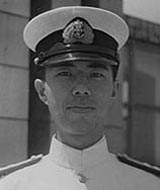 |
| In my navy lieutenant's uniform |
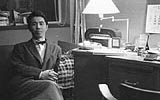 |
| In Harvard dormitory room |
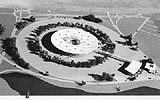 |
| Shopping Center design done at Harvard |
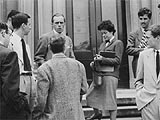 |
Classmates, Alfred Roth
in the center |
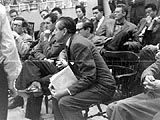 |
| Professors at "Design evaluation" |
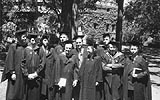 |
| In cap and gown at Harvard graduation (far right) |
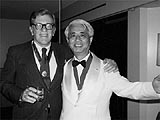 |
With Hugh Stubbins,
at the AIA convention,
Kansas City |
 |
| Marcel Breuer, Yoshimura Junzo and myself |
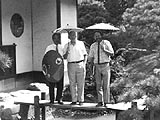 |
| Marcel Breuer in Japan |
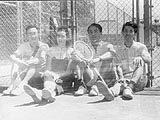 |
| With Nakasone Yasuhiro (second from right) |
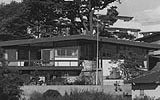 |
| Split-level residence designed for Nakasone Yasuhiro |
 |
| Section of the residence |
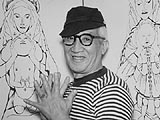 |
My uncle Leonard Foujita
in Paris |
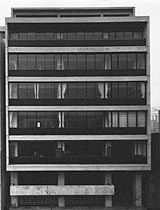 |
| Chuo Koron Building |
|
 |